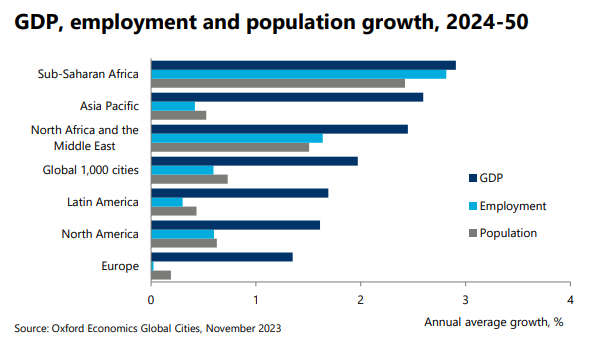Africa: The long-term outlook for sub-Saharan African cities
Sub-Saharan cities will lead the way for GDP growth, but similarly strong demographic changes will limit gains in GDP per person, reaffirming the region’s position at the lower end of the development spectrum.
What you will learn:
- GDP in sub-Saharan cities will increase at an annual average rate of 2.9% during 2024-50, comfortably outpacing all other parts of the world. However, what makes its position unique is the demographic outlook. While in other regions we forecast GDP growth to be markedly stronger than employment and population, in sub-Saharan cities this growth disparity narrows considerably.
- The implication of similar growth for GDP, employment, and population, is that sub-Saharan cities will continue to trail behind the rest of the world when it comes to GDP per person. Indeed, we forecast that GDP per capita in 2050 will be just 13.6% higher than in 2023, which is only a third of the gains expected in Latin America: the region with the second weakest outlook. Economic growth in sub-Saharan cities will instead be driven by large-scale population changes as opposed to productivity gains, something that will constrain income growth and the purchasing power of residents.

Tags:
Related Posts

Post
Africa: The longer-term outlook for sub-Saharan African cities
Sub-Saharan Africa will be at the very epicentre of global urbanisation over the next two decades, with the world’s top 20 fastest growing cities for population all being found in the region.
Find Out More
Post
Africa safeguarding food stability in times of crisis
The Russia-Ukraine war is set to have serious implications for wheat supply and food stability in Africa. Despite efforts by governments to limit the passthrough of rising commodity prices to consumers, it will be nearly impossible for many African countries to escape rising global food prices, given that food accounts for between 30% and 50% of the CPI basket in most cases.
Find Out More
Post
Cities Key themes 2024 – cyclical swings, structural shifts
Growth in the main economic indicators (GDP, employment, and consumer spending) is likely to be weaker in 2024 than in 2023 for most cities around the world. And a recurring theme for debate will be where cities sit within their national economic cycles.
Find Out More